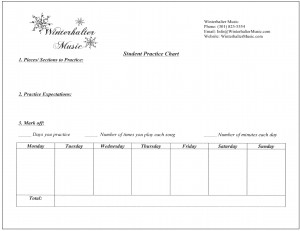Happy October! I’m thrilled that Fall is here. The leaves are falling, days are getting cooler, and it’s time for all things pumpkin! Our students are getting excited about Halloween and have been sharing their costume selections with me.
Today I get to talk about one of the topics that never ceases to recur with music lessons…..practicing. While some students practice on their own with no reminders or extra incentive needed (was me as a child), for most students, this is not the case. Most students need a little extra motivation to keep the practicing momentum going.
One of the best ways to keep the practicing flowing is by using of a practice chart. A practice chart allows students to mark off when they practice, which ensures that they actually do it. Most kids don’t like having nothing marked off in their practice chart when their teacher returns for a lesson the next week. Just knowing that their teacher will see the chart in a week’s time is motivation enough to use it.
Check out the practice chart below that I’ve created:
You can download and use it anytime. Just click the link here.
Your teacher will fill out the top three sections:
#1: Pieces/ Sections to Practice
Your teacher will list what he wants you to practice this week. This may be shorter pieces or sections of a longer piece. He’ll also include notes on what you should specifically pay attention to in each piece/ section- ex: your rhythm, dynamics, etc.
#2: Practice Expectations
Here your teacher will list the practice expectations for the week. This may be practicing 5 days a week for 15 minutes a day or practicing in sections or paying attention to details while you practice.
#3: Mark Off
When I use the practice chart I have students use it one of three ways, which I delve into more below. Your teacher will mark the way he thinks will be most helpful for your son or daughter to use the chart.
1: Students mark off the days they practice
Students will check or place an X on each day they practice. This works well for students who are good at practicing effectively, but due to being busy, sometimes forget to practice.
2: Students mark the number of times they play each song
Here each time a student plays through a song they mark an X. This works well for very young students.
3: Students mark the number of minutes they practice each day
With this approach students keep track of how many minutes they practice each day of the week. This is appropriate for older/ more advanced students that need to spend more time practicing.
Check out this blog post if you’re curious about how much time your child should spend practicing.
At the end of the week, the student can enter the total. It will be either the total days practiced during the week, the total times they played their songs, or the total minutes practiced during the week. Each week students will use a new chart. I highly suggest offering some type of reward to your kids if they meet their teacher’s expectations on practicing for a certain length of time.
If you want more tips on practicing, check out these posts: How to help your kids practice without asking or reminding them and How to help your kids practice if you’re not a musician yourself.
Now I want to hear from you. How has using a practice chart helped your kids with their practicing? What other practice tips have you found helpful with them? Leave a comment below. Subscribe to the newsletter and “like us” on Facebook. Have a wonderful day, and I’ll catch you again next Thursday!
Sincerely,
Cassie

{ 1 comment… read it below or add one }
I’ve been wanting to make a practice sheet for my students! I’ve had success with Suzuki’s 100 days of practice chart too actually. I simply set a practice time goal, something relatively easy to accomplish, and if they practiced that amount of time they can check that day off.
The reason I set a low practice amount is because I think this is more about consistency (we’re going for 100 straight days, including weekends!) and creating a habit than trying to increase practice duration.
In my experience, the first 10-20 days are the most critical, after that the student starts to get momentum and they won’t want to break their “chain” (the Jerry Seinfield method!).
{ 1 trackback }